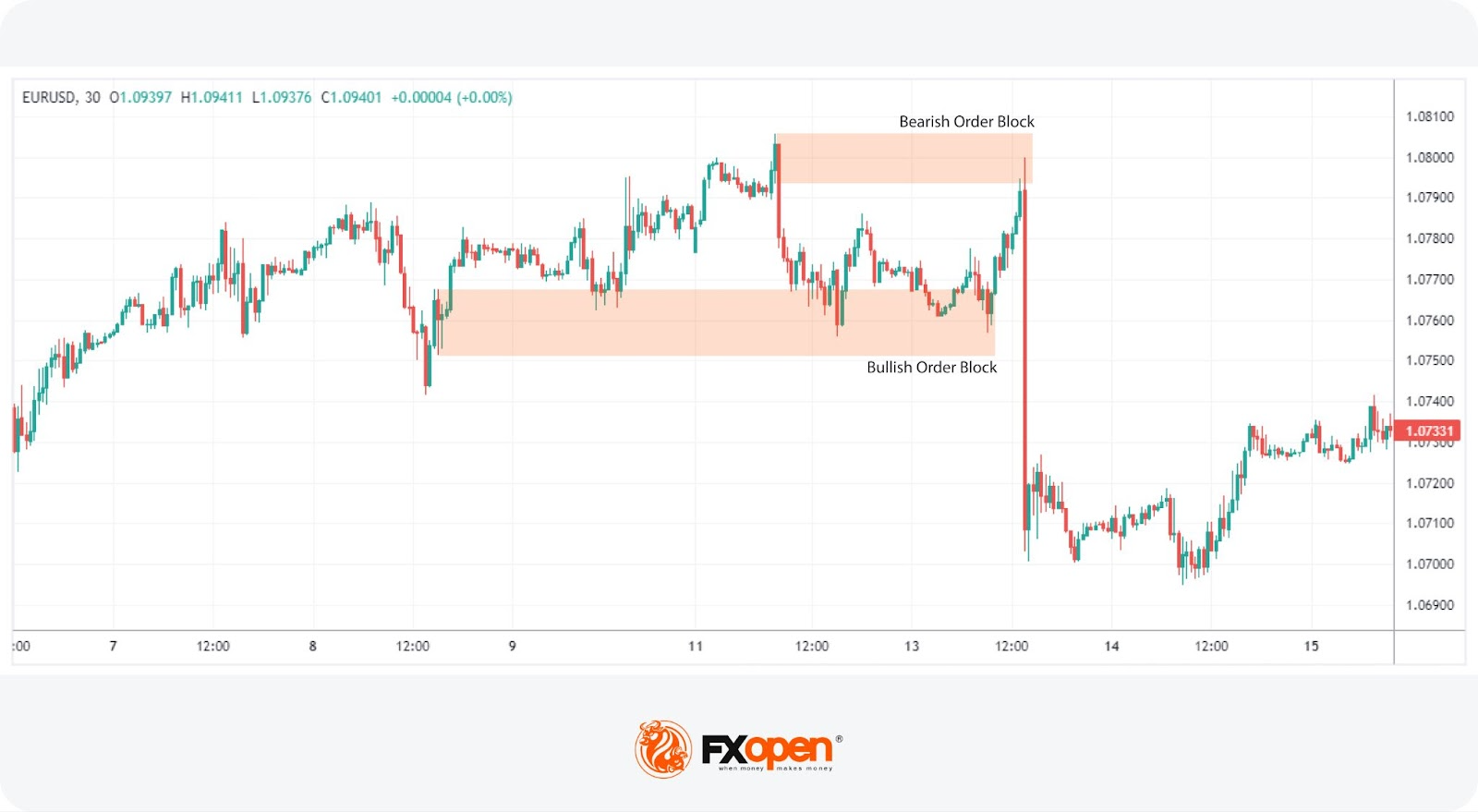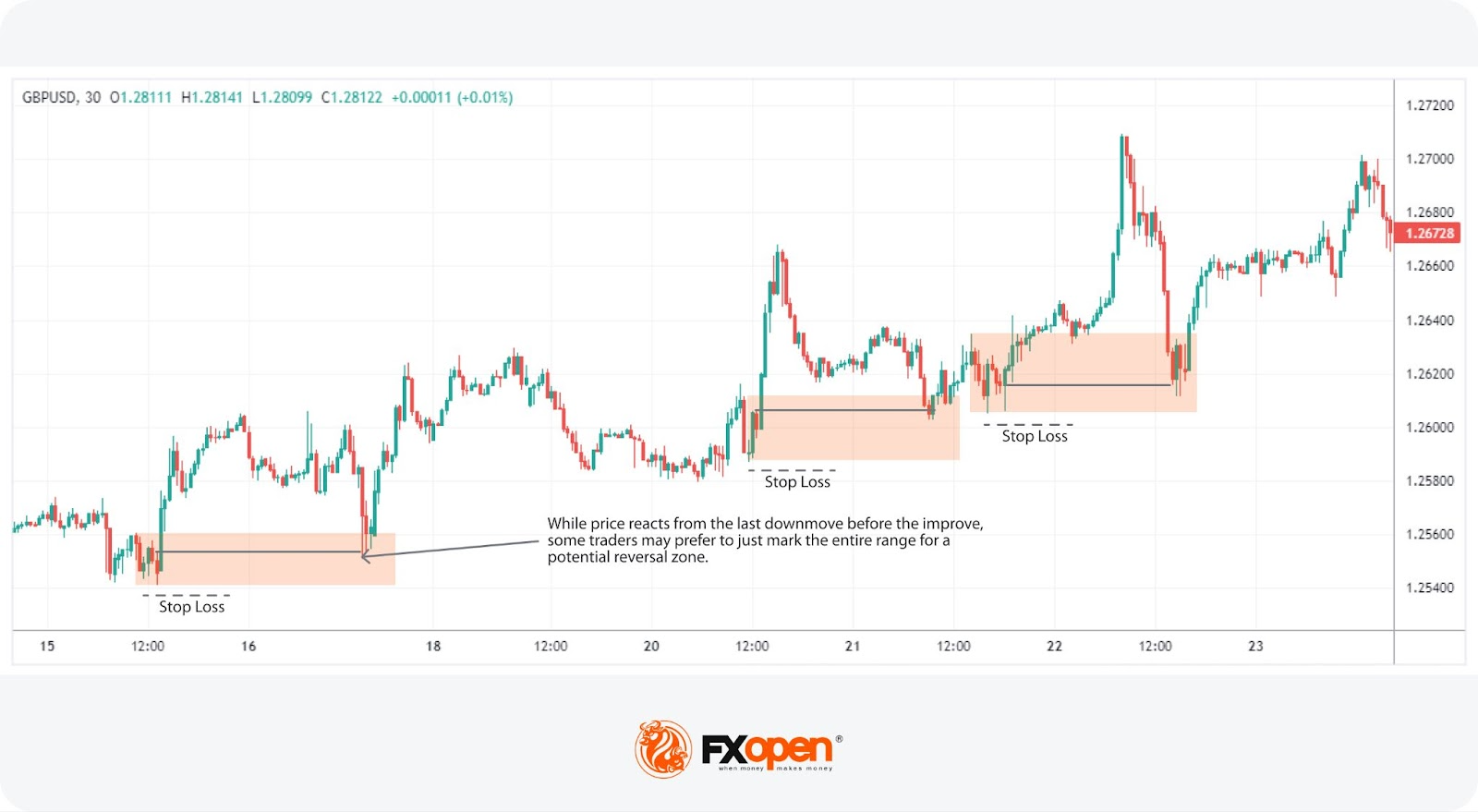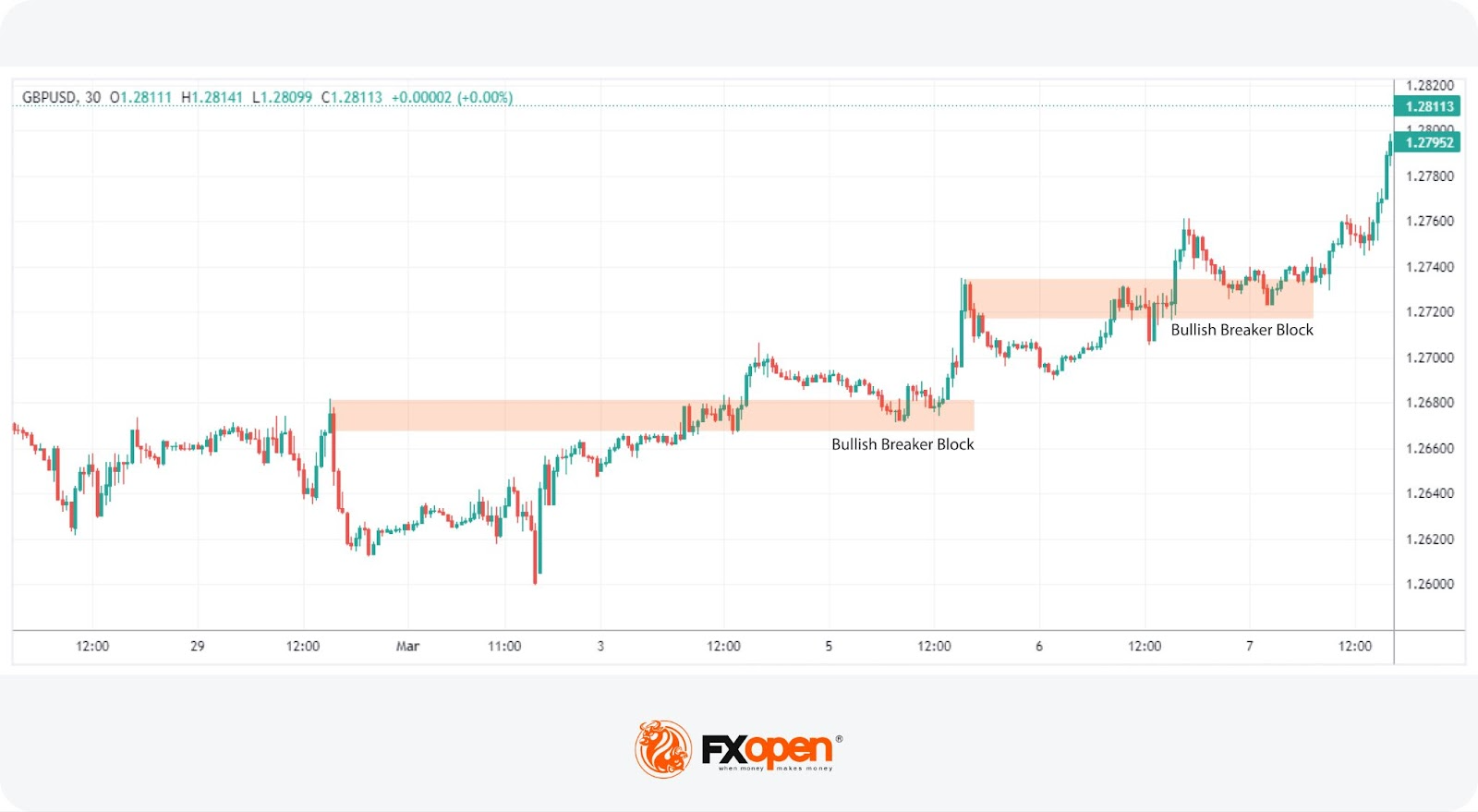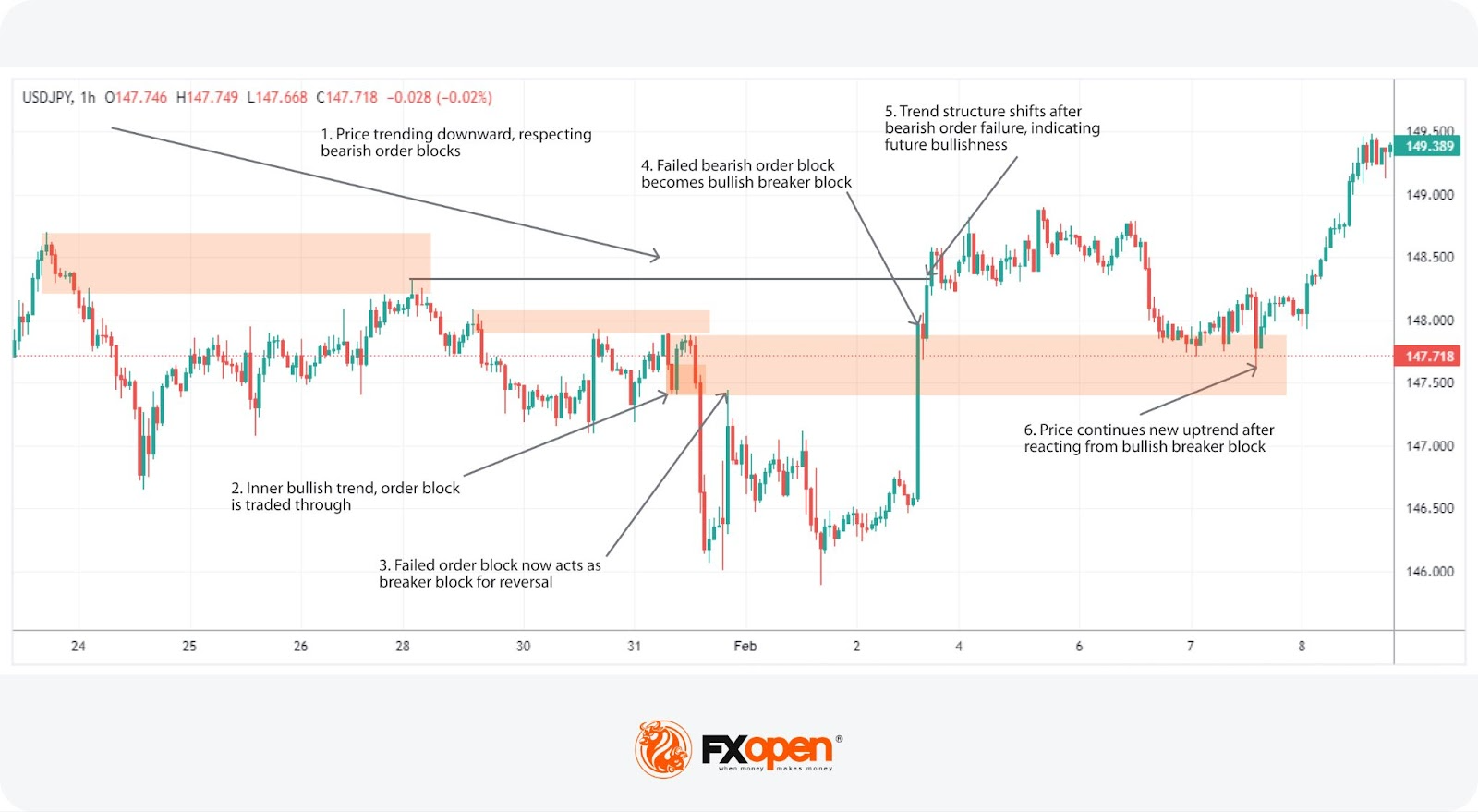FXOpen

Order blocks and breaker blocks are important price action structures. These formations reflect zones where large market participants—often referred to as smart money—execute significant buy or sell orders, influencing market direction.
Although many retail traders overlook these patterns, understanding them can support traders when analysing market direction and detecting potential reversals or trend continuations. This article provides a detailed breakdown of the order block vs the breaker block, outlining their definitions, distinctions, and practical applications in market analysis.
What Is an Order Block?

An order block, also known as a supply or demand zone, represents a significant area on the price chart where large market participants, such as banks or institutional traders, have placed substantial buy or sell orders. They’re crucial in understanding the flow and direction of an asset, as they often precede notable movements in price. Particularly in the realm of forex, where the magnitude of transactions can be immense, identifying these zones can provide traders with a strategic edge.
A bullish order block, or demand zone, is identified during a downward price movement and is the area where the last bearish candle before a substantial upward price movement occurs. This indicates that institutional buyers are stepping in, absorbing sell orders, and preparing to push the price higher. Traders eyeing bullish order blocks anticipate these areas as potential points of interest where price may find support, thus offering a strategic entry point for long positions.
Conversely, a bearish order block, or supply zone, is found during an upward price movement and is characterised by the area where the last bullish candle appears before a significant downward price shift. This suggests that institutional sellers are overwhelming buyers, likely leading to a decrease in price. Bearish order blocks act like resistance zones, which traders often use to enter short positions in anticipation of a downward price trajectory.
In both instances, they typically create an impulse move that breaks a nearby high or low to continue or start a given trend. When the market returns to these areas, they often prompt a reversal of the short-term trend and a continuation of a higher timeframe trend.
Order blocks in forex are particularly telling due to the high market liquidity and the sheer volume of trades. Recognising these areas may help traders align their strategies with the likely actions of major institutional players, potentially leading to more informed trade decisions.
Why Order Blocks Are Popular Among Traders
This pattern works because they tap into the underlying dynamics of supply and demand, reflecting the actions of large institutional players whose trades can significantly impact price direction. They’re essentially snapshots of where significant buying or selling pressure has accumulated, offering clues to future price movements.
When a market approaches a supply or demand zone, the likelihood of a reaction—whether it's a continuation or reversal of the trend—increases because these levels are where institutional traders have previously shown interest, either by initiating large positions or placing take-profit orders.
Finding and Using Order Blocks

Now, let’s take a closer look at how to identify and use order blocks for trading.
Identifying Order Blocks
Traders often start by analysing historical price charts to locate this pattern. Typically, these are found where there was significant trading activity, often in the form of a consolidation, followed by a strong directional price move.
A bullish order block is where the last bearish candle in a downtrend occurred before a sharp rise. Conversely, in a bearish order block, traders identify the last bullish candle before a significant fall.
Note that order block candles visible on a higher timeframe tend to be more probable. Similarly, a small high-low range on a lower timeframe would appear as a single candlestick on a higher timeframe, meaning that the entire range can be plotted as a supply or demand zone.
If you want to spot your own patterns, you may consider heading over to FXOpen’s TickTrader platform and interact with real-time charts.
Incorporating Order Blocks into a Trading Strategy
An order block trading strategy involves observing how the price behaves as it approaches these marked areas. Traders typically watch for price reactions near these zones, using them as indicators of potential entry or exit points. For instance, a price bounce from a demand zone may be used by traders to place a buy order, anticipating upward momentum as institutional interest possibly resurfaces.
Traders might also combine these areas with indicators and other analysis tools, such as moving averages or Fibonacci retracements, to validate their signals. This multi-faceted approach may support traders in developing their own entry and exit strategies.
Risk Management
As with any strategy, it's crucial to practise sound risk management when trading with order blocks. Traders often set stop-losses just outside the zone with the assumption that institutional players won’t let the market trade beyond this point. However, when these zones fail, they become known as breaker blocks.
Understanding Breaker Blocks in Forex

In the realm of forex, understanding the concept of breaker blocks can be crucial when it comes to identifying potential reversals and continuations in trends. Breaker blocks emerge from the failure of order ones. When these supply or demand zones do not hold, and the market structure shifts, breaker blocks are formed, marking significant levels to watch.
A bearish breaker block occurs after a bullish order block fails. This typically happens when there's an upward trend, and a certain level that was expected to support the market's rise instead gives way, leading to a sharp decline. This decline indicates that sellers have overcome the buyers, absorbing liquidity and shifting the sentiment from bullish to bearish.
Conversely, a bullish breaker block is formed from the failure of a bearish order block. In a downtrend, when a level that was expected to act as resistance is breached, and the price shoots up, it signifies that buyers have taken control, overpowering the sellers.
In both scenarios, price often retraces to the failed zone before continuing the newly formed trend.
Finding and Using Breaker Blocks

To harness the power of breakers, traders adeptly identify these pivotal points and integrate them into a coherent strategy.
Identifying Breaker Blocks
The first step involves scrutinising price charts for significant reversals that follow the failure of established supply or demand zones. A bearish breaker block, for instance, would be marked by a sudden decline after a bullish trend fails to sustain, trading through a bullish order block, and vice versa.
The most notable breaker blocks are often the order blocks that stand out visually or would need to stay intact if a given trend is to continue. When they fail, they can then be plotted as a valid horizontal level to look for a retracement before a potential move away.
Strategic Application
Once identified, these zones can be strategically employed as markers for potential trade entries. For a bearish breaker, traders might consider short positions, anticipating further declines as price retests and rejects the previously failed support level. Conversely, a bullish breaker suggests a potential long position as the market may continue to rise, having breached a significant resistance.
Combining Order Blocks and Breaker Blocks

Combining these two ideas offers a nuanced approach to forex, especially when integrating the concept of liquidity voids or fair value gaps. These gaps occur when the price makes an impulsive move away from an order block without retracing, potentially marking areas for future reversals. This strategy shines in trending assets, where the directional momentum aligns with the formation of these critical zones, offering potential entry and exit signals.
Trending and Ranging Markets
In a trending market, order blocks that prompt sharp price movements away can be key areas to mark for a trend reversal. These marked zones can indicate where significant buying or selling pressure originated, offering potential entry points. However, it's essential to recognise that in a ranging or consolidating market, they might not hold as expected.
The Role of Breaker Blocks
When institutional interests shift, leading to the failure of an order block to act as support or resistance, this is where breaker blocks come into play, becoming a critical level to watch. Particularly after a sudden move, if a supply or demand zone ripe for reversal is now too far away to see an immediate retracement, the breaker serves as a strategic entry point ahead of a trend continuation.
Setting Market Direction with Breaker Blocks
Breaker blocks may help set market direction and reflect potential entry points. The breach of an order block by price action indicates a strong likelihood that the asset will continue in that direction, underscoring a shift in institutional interest. When price trades through an order block, showing no signs of halting, it suggests a path for the trend, offering traders insight into the prevailing momentum.
Limitations of Order and Breaker Blocks
While these patterns provide insightful strategies in navigating forex markets, they come with limitations that traders should be aware of:
- Market Volatility: High volatility can disrupt the reliability of these zones, leading to false signals.
- Institutional Disguise: Large market players may mask their activities, making it challenging to identify genuine order or breaker blocks.
- Lagging Indicators: These areas are based on past price behaviour, which might not always be useful when analysing future movements.
- Overreliance: Solely depending on these strategies without incorporating other analyses can lead to missed trades or misinterpretations.
The Bottom Line
An understanding of breaker blocks vs order blocks may support traders in navigating the forex market, as these concepts provide valuable insights into institutional order flow and market movements. By understanding how these structures form and the psychological dynamics behind them, traders can anticipate potential reversals or continuations. However, these patterns may provide false signals, so traders prefer to use them alongside broader market context, volume analysis, and strict risk management.
Those who want to apply these insights in real-time trading, may consider opening an FXOpen account, a gateway to the dynamic world of forex, connecting traders with global markets.
FAQs
What Is an Order Block in Trading?
An order block refers to a price area on the chart where significant buy or sell orders were previously placed by large institutional traders. These zones are important when identifying potential support or resistance levels, providing insights into future price movements.
What Is a Breaker Block in Trading?
A breaker block is a concept that emerges when an order block fails, leading to a change in market structure. It signifies a pivotal point where the market shifts direction, allowing traders to open a trade based on anticipated trend continuation.
How May Traders Identify Order Blocks?
Order blocks can be identified by analysing price charts for areas where there was significant trading activity, followed by a strong directional movement. Traders look for the last bullish candle before a downturn for a bearish block, or the last bearish candle before an uptrend for a bullish block, indicating potential zones of interest for traders.
This article represents the opinion of the Companies operating under the FXOpen brand only. It is not to be construed as an offer, solicitation, or recommendation with respect to products and services provided by the Companies operating under the FXOpen brand, nor is it to be considered financial advice.
Stay ahead of the market!
Subscribe now to our mailing list and receive the latest market news and insights delivered directly to your inbox.








